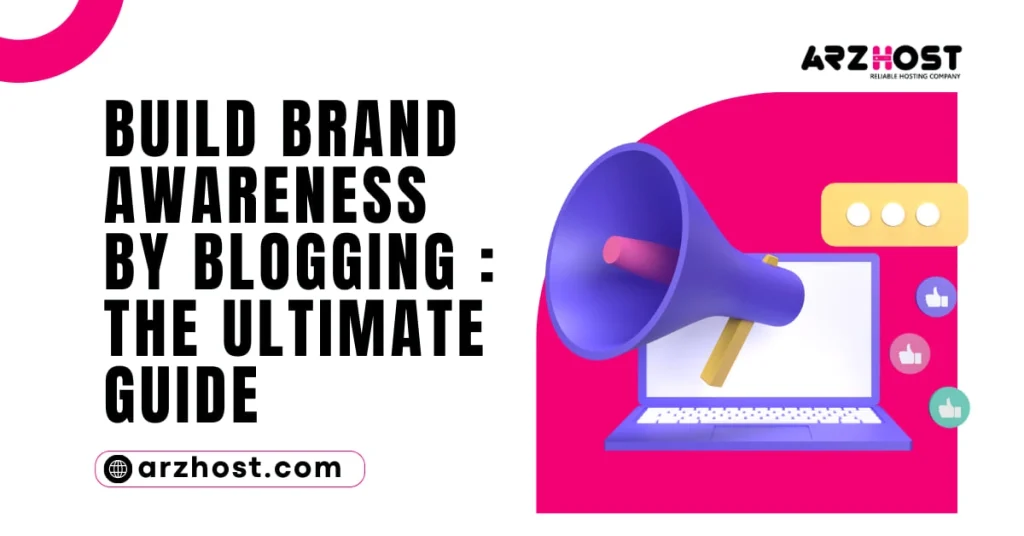Build Brand Awareness by Blogging: Comprehensive Guide to Outrank the Competition
We’re glad you’re here for our thorough guide to Build Brand Awareness by Blogging for brand exposure. In this post, we’ll go in-depth on the methods and tactics that can help you outrank your rivals on Google and build a solid online presence.
Build Brand Awareness by Blogging has shown to be an effective technique for obtaining new clients as well as demonstrating your knowledge and authority in your field. Blogging has developed from a basic online journal to a powerful marketing tool that companies all over the world are using to increase brand awareness.

By blogging, you may provide valuable and pertinent content that informs and engages your target audience, increasing traffic to your website. However, how can you ensure that your blog posts stand out and achieve better Google rankings?
At ARZ Host, we are aware of the impact blogging can have on improving your company’s internet visibility and generating organic traffic for your website. We will go deeply into the methods and strategies for writing interesting, keyword-rich blog posts that can outperform other websites on Google in this in-depth course.
What is Brand Awareness?
Brand awareness is the degree of knowledge and recognition that a brand has among its target market and the general public. It is an important marketing indicator that shows how well a brand is recognized, remembered, and connected to its goods or services.
When consumers are familiar with a brand, they can quickly recognize it when given the name, logo, or any other identifying characteristics.
Build Brand Awareness by Blogging is crucial for organizations because it serves as the basis for customer engagement, brand loyalty, and trust. Consistent and purposeful communication through a variety of channels, including advertising, social media, public relations, and content marketing, is a key component of a successful brand recognition plan.
Surveys, brand recall tests, and the monitoring of internet mentions and interactions are frequently used to measure brand awareness. High brand recognition can result in more sales, more customers, and a competitive advantage.
In the end, successful brand awareness projects assist a brand in establishing a prominent and favorable position in consumers’ perceptions, resulting in long-term success in the market.
Build Brand Awareness by Blogging may appear to be an ambiguous idea, and it actually is. Brand awareness will probably annoy marketers and business owners who want to measure success with nice and tidy metrics.
But that doesn’t imply it doesn’t have worth just because it’s not a statistic that can be precisely established. For a business to succeed and achieve its overall marketing objectives, brand recognition is important.

Build Brand Awareness by Blogging has become an essential element for businesses looking to stand out in their various industries in today’s fiercely competitive business environment. We recognize the value of developing engaging content that not only engages the readers but also helps websites outperform their rivals on Google as a leading SEO and high-end copywriter.
In this article, we figure out the reasons that brand recognition is important for businesses and how it affects their success online. Brand awareness is the level at which a particular brand is known to and recognized by its intended market.
It includes more than just having a memorable logo or catchy tagline; rather, it refers to how people perceive a brand as a whole. Customers’ purchasing decisions are greatly influenced when they can quickly recognize a brand and relate it to favorable qualities.
1: Establishing Trust and Credibility
The important role that brand awareness plays in establishing credibility and trust is one of the main reasons why it is so essential. Given the abundance of options available to them nowadays, consumers are more likely to choose well-known and reliable brands.
A strong brand with high recognition is more likely to be viewed as trustworthy, which boosts repeat business and client loyalty.
2: Enhancing Customer Loyalty
Brand recognition is essential for encouraging client loyalty. Customers often grow attached to and loyal to a brand when they are frequently exposed to it through a variety of marketing methods.
Even if different companies provide comparable goods or services, they are more likely to choose that one over others. For competitors looking to enter the market, this consumer devotion presents a strong barrier.
3: Driving Customer Engagement
Improved customer involvement is a result of high brand recognition. Customers are more likely to interact with a business on social media, sign up for newsletters, enter contests, and post reviews when they are familiar with it.
This conversation not only offers the brand useful feedback, but it additionally creates a sense of community, which enhances the company’s reputation.
4: Word-of-Mouth Marketing
A well-known brand develops from word-of-mouth marketing’s tremendous impact. Customers who are happy with a brand and feel a deep connection to it are more inclined to tell their friends, family, and coworkers about it.
Positive word-of-mouth recommendations can lead to a natural rise in brand recognition since prospective buyers are more willing to check out a product that has received a lot of praise.
5: Gaining a Competitive Advantage
Any company expecting online success must prioritize outranking rivals on Google. Companies with strong brands have an advantage over rivals because they can stand out in a crowded marketplace.
When a company is well-known and well-established, more people visit its website and social media pages, which eventually boosts sales and conversions.
6: Expanding Market Reach
We know that effective content marketing is crucial for extending a brand’s market reach because we are skilled SEO and copywriters.
A well-known brand tends to have content that reaches a larger audience since more people are inclined to share, interact with, and comment on it. This wider audience not only increases organic traffic but also creates opportunities for future partnerships and collaborations.
7: Building Brand Equity
A brand’s fundamental worth, which includes its reputation, perception, and connotations, is referred to as brand equity. Building brand equity is directly influenced by strong brand awareness.
Customers form specific impressions and feelings about a brand as they repeatedly come into contact with and identify it. A great brand image is a vital asset for any firm, and strong brand equity follows.
8: Staying Relevant in the Market
Achieving long-term success in the frantic and constantly evolving corporate environment requires staying relevant. High-awareness brands are better able to change with market developments and customer preferences.
As a result of their audience’s ongoing exposure and interaction, they gain insightful information that enables them to innovate and create goods and services that cater to changing consumer needs.
Brand recognition is unquestionably important for companies looking to rule their respective marketplaces. It encourages client loyalty, credibility, and trust while promoting engagement and word-of-mouth advertising.
A strong brand with great recognition develops substantial brand equity, broadens its market reach, and has a competitive edge.
As skilled SEO and premium copywriters, we recognize the critical importance of brand exposure in the current digital era.
Why is Brand Awareness Important?
When consumers think about the kind of goods or services you sell, your brand comes to mind first thanks to strong brand awareness and brand recognition. It is simpler to communicate effectively through social content, especially in photographs or short-form videos, when people are familiar with your brand or tagline.
Building brand loyalty requires first creating brand awareness. Customers can’t adore your brand until they are aware of it and can recognize it, after all.
Imagine the difference between generic store brand cola and Coke. Nobody is sporting a T-shirt proclaiming their passion for cheap cola. Yes, people do purchase it, usually because it is the least expensive choice. However, nobody is promoting the generic brand.
Typically, the most recognizable brands are the most valued. The most valuable clothing brand is Nike. The consumer technology category is won by Apple. And Coca-Cola is the best beverage and food on the market.
You don’t have to be as big as these massive companies to Build Brand Awareness by Blogging, but there are many things you can learn from how these businesses have developed their identities.
How Can Bloggers Be Used to Build Brand Awareness?
Build Brand Awareness by Blogging has become essential to any effective marketing plan in the modern digital age when the internet environment is continuously changing. Brands are constantly looking for novel approaches to differentiate themselves from the competition.
Among the many strategies used for doing this, using bloggers to your advantage has become a potent instrument to increase brand visibility and awareness.
The voice of the internet is now mostly comprised of bloggers, often known as influencers. They have sizable, devoted fan bases, and their recommendations and opinions have a big influence on their audience.
By working with bloggers, brands can access this significant audience and establish an engaging and genuine connection with those they want to reach.
1: Authenticity and Credibility
The fact that bloggers can have a substantial impact on brand recognition is due in large part to their trustworthiness and sincerity. Bloggers provide content in their own distinctive voices, forging real connections with their readers as opposed to traditional advertising, which can come off as commercial and disingenuous.
When a blogger recommends a company or item, it appears more like a personal endorsement than paid marketing.
2: Niche Targeting
A specialized audience typically connects with a blogger’s focus on a certain niche or area of expertise. Brands can precisely target their ideal clients thanks to this specialty targeting. Businesses are able to expand their reach to prospective clients who are truly interested in their offerings by cooperating with bloggers whose readership matches the brand’s target demographic.
3: Amplified Content Distribution
Businesses can gain from increased content dissemination by using bloggers as brand ambassadors. When a blogger mentions a brand in a blog post or on social media, it may result in more likes, shares, and comments, which helps spread the company’s message to more people.
Build Brand Awareness by Blogging: This exposure can help build brand identification and awareness.
Effective Strategies for Harnessing Bloggers for Brand Awareness
It’s obvious that bloggers may be quite helpful in increasing Build Brand Awareness by Blogging, but a successful collaboration demands a well-thought-out plan. Here are some practical methods for maximizing blogger collaborations:

1: Influencer Research and Selection
Finding the ideal influencers to work with requires extensive investigation. Finding bloggers whose writing and principles closely reflect the brand’s values should be the main objective. The importance of authenticity cannot be overstated, and an influencer who genuinely connects with the goals of the business will be better able to spread its message.
2: Engaging Content Creation
Brands should spend money on creating engaging and relevant material if they want to properly engage the blogger’s audience. The writing should reflect the blogger’s personality while also highlighting the brand’s distinctive selling characteristics.
Regardless of whether the material is a blog post, social media feature, or video review, it should be valuable to the audience and seamlessly incorporate the brand.
3: Social Media Collaboration
Collaborations with bloggers on social media can produce amazing effects in addition to blog pieces. Platforms like Instagram, YouTube, and TikTok present exceptional chances to present goods or services in a captivating and visually appealing way.
Making use of the blogger’s social media presence and inventiveness can greatly increase brand visibility.
4: Monitoring and Measuring Success
Monitoring and evaluating the success of blogger collaborations is essential just like with any marketing strategy. Brands should monitor key performance measures including website traffic, social media interaction, and sales produced as a result of the partnership.
This information will be used to evaluate the campaign’s success and offer insightful information for potential future partnerships.
In the current digital environment, bloggers have evolved into important partners in an effort to raise brand recognition. For companies looking to increase brand awareness, their authenticity, niche targeting, and prominent reach make them great partners.
Brands may use the influence of bloggers to make a long-lasting impression on their target audience by putting out effective strategies and cultivating real partnerships.
How to Build Brand Awareness?
It takes time to build brand recognition among your target audience and the general public. Additionally, it doesn’t result from straightforward marketing or advertising initiatives. Strong brand recognition is the outcome of numerous concurrent efforts that go beyond attempting to attract paying customers.
You won’t get very far if you try to increase brand awareness by placing a few product adverts on Facebook. The consumer will not only be more interested in the product (rather than the brand), but the advertisement will also have little impact beyond a straightforward sale.
Here are some strategies for building a strong brand awareness foundation and leaving a long-lasting mark on your audience:
1: Be a Person, not a Business
What do you prefer to learn about someone that is unfamiliar as you get to know them? I enjoy finding out about people’s interests, passions, preferences, and other things. I also pay attention to their speech patterns, topics of interest, and sources of excitement.
These are the qualities that your brand should identify and highlight. You need to define yourself as more than a business that transacts business if you want to make an impression on your audience.
How else might you describe who you are? What phrases would you use to introduce your company to a brand-new friend?
2: Socialize
Everyone benefits from social interaction and spending time with others, whether they are quiet or gregarious, introverts or extroverts. It’s how we remain in touch, grow intellectually, and meet new people.
Your brand is no different. You won’t be known as anything other than a business with a single purpose if you just make an effort to connect with people when you’re attempting to make a sale or gain support.
You need to be social if you want to increase brand awareness. Share content on social media that has nothing to do with your goods or services. Ask questions, leave comments on posts, or retweet or share anything you find interesting to engage with your audience. Utilize your social media platforms as though you were a person seeking to make friends rather than a company looking to generate money.
According to research, social interaction online accounts for over 50% of brand reputation. Being socially active results in increased awareness and simple recognition.
3: Relate a Story
Whether you’re selling things or building your brand, storytelling is an immensely effective marketing strategy. Why? because it provides a genuine anchor for your audience to grasp.
Making a story for your brand humanizes it and gives it character. And incorporating the aforementioned narrative into your marketing naturally markets both your brand and your goods or services.
What should the subject of your story be? whatever you want, as long as it’s true. It can be the biography of your company’s founder, the account of how your company came up with its first product concept, or the tale of the “little engine that could”—how your modest company succeeded in the competitive business world.
People enjoy learning about one another through storytelling. Authenticity has an impact and can significantly increase brand awareness.
4: Simplify Sharing
Make it simple for your audience to share your material, no matter what your sector is, what you have to offer, or your marketing tactics. These could be product pages, blog entries, videos, social media posts, or sponsored material. Whatever it is, as long as it can be shared, is acceptable.
The most efficient method of building client trust and familiarity is through word-of-mouth marketing. Someone will pay attention to a product… and brand if they see that a friend or family member is endorsing it.
Is this a company worth looking into? Do they provide any more top-notch goods that I can trust? How do their social media accounts look and what topics do they discuss?
Customers will increase brand awareness for you by clicking “Share” if you make it simple for them to post about your products.
Build Brand Awareness by Blogging is all about effect. It involves engaging with your audience in ways that don’t just solicit donations, involvement, or allegiance.
How would you feel if you met someone new and they asked to be your friend? You’d probably laugh and leave if they asked for any of the aforementioned things, aren’t you right? That is not only a superficial approach to friendship, but it also has no long-term effects on you.
Creating and growing brand recognition within your audience works similarly.
6 Strategy for Brand Awareness
You are already aware of how to begin developing your brand recognition from the start. It’s time to set together a straightforward yet effective brand awareness strategy to keep the flywheel going.
1: Guest Blogging on Specialized Websites
One of the highest quality low-effort strategies to raise brand exposure is guest blogging. Utilizing the traffic that is already going to another website, you may increase awareness of your business while providing relevant and valuable content.
In other words, instead of simply pushing your goods on individuals who aren’t ready to buy, write in your brand voice and come across as a real person, first and foremost. Sponsored content publication on specialist websites would be a fantastic alternative to guest blogging.
2: Consider Co-marketing
Co-marketing is a great strategy to increase brand recognition since it can highlight who you are and what you have to offer in the marketplace while also allowing you to capitalize on the audience of another company.
For example, you might collaborate with a dog walking app if your business provides dog leashes and toys. The campaign itself could manifest in a variety of ways, including You might make a joint promotion (such as “download the app and get one free leash”) or organize an Instagram live event with a friend. Whatever the case, working together with another brand could help you increase your reach by two or even threefold.
3: Always use Advertising
Advertising is one of the best musical instruments you can use to spread awareness of your brand in a low-touch, discreet manner, even while it may not increase brand awareness as much as it does product awareness.
Think about Grammarly. It seems like nobody was aware of Grammarly until a few years ago. Now, when you think of online proofreading software, you immediately think of this brand. That’s a result of their aggressively distributed display, video, and social advertising strategies.
Build Brand Awareness by Blogging is all about Online advertising, which includes paid social media and PPC, and is something you might want to start with. You can start programmatic advertising campaigns if you want to be seen everywhere and launch more complex initiatives on a large scale.
4: Create a Mascot for the Business or Hire a Face
Smaller businesses might not be able to afford this, but if you do, think about employing an actor or spokesperson to represent the business. When you think about Progressive, what comes to mind first? Flo is known as the “Progressive girl” due to her outgoing and amiable nature.
This enables you to not only humanize your business, as was described in the previous section but also to convey the kind of helpful customer care that they may anticipate.
You’re not required to employ anyone. A great example of this is GEICO. As soon as you spot that amiable reptile, you recognize GEICO. An inexpensive but equally powerful way to give your brand a face is by creating an animated mascot.
5: Pick a Picture or Symbol that Best Reflects You.
Nike is no longer even Nike. A check mark appears. When you see that checkmark, you immediately recognize it as Nike. How about the yellow “M” from McDonald’s? Or the bitten apple of Apple?
I’m not simply talking about a logo, though it may undoubtedly be a component of your logo. But build a symbol that you consistently utilize in your marketing, advertising, and organic campaign work with your branding team or a freelance graphic designer.
You might also think about following the lead of Nike, McDonald’s, and Apple and incorporating the emblem into the packaging and design of your goods.
6: Develop a Brief, Memorable Slogan.
Using Nike as an example, you probably immediately think of the company when you hear the slogan “Just do it.” One of the most effective and straightforward ways to raise brand awareness is by developing a catchy motto or phrase.
It’s challenging to summarize every aspect of your personality in a single statement; try it. It must describe how you’re unique, what you have to offer, and why they should pick you.
Think about the slogan of ARZ Host: “Faster Web Hosting to Help You Succeed!” You now comprehend in just four phrases why you should select our product over other marketing automation platforms.
How to Increase Brand Awareness?
Promoting brand awareness is essential for companies looking to have a strong online presence and stand out from the competition in the modern digital era. Effective techniques must be used in order to stand out and be seen among the many websites fighting for users’ attention online.

How about increasing your already-strong brand recognition and constructing upon it? What can your company do to promote itself and consistently raise awareness?
This thorough guide will cover five successful tactics for increasing brand recognition and outranking rival content on Google.
1: Offer Premium Products and Services
A key component of creating a trusted brand is offering high-quality goods and services. Customers are more inclined to spread their positive experiences with others when they are pleased with the quality they obtain. Positive word-of-mouth can have a big impact on brand recognition and reputation for your company.
An essay outlining the advantages of providing high-end goods and services would emphasize how providing exceptional value cultivates brand champions in the form of devoted customers.
It should explore why consumers are prepared to pay more for quality and how this benefits the brand’s reputation as a whole.
2: Create Valuable Free Content
A powerful strategy for attracting new clients and establishing your brand as an authority in your sector is to produce valuable free material. You may establish your brand as a useful resource by providing insightful blog entries, tutorials, and educational films.
A post outlining the benefits of free material would stress how it aids in establishing credibility and trust with the readership. It would emphasize the value of using content marketing to solve problems and offer workable answers.
It’s not necessary for content to be in writing. Additionally, you may produce infographics, podcasts (which we’ll discuss shortly), movies, and more. Though they’re undoubtedly the simplest, written content like blogs and downloaded manuals are by no means the only choice.
Additionally, content need not only exist on your website. Opportunities to reach out to new audiences and diversify the kinds of material you produce are offered via guest posting and sponsored content.
You can be losing out on some significant potential for brand visibility if your company isn’t producing content. A fantastic method to really engage with your audience and promote your company is through content.
3: Sponsor Events and Engage with the Community
By supporting events, your business can reach a wider audience and establish more personal connections with potential clients. Your business becomes connected with satisfying experiences when you support pertinent events, which can leave an impression on attendance.
In a piece on the effects of event sponsorship, it would be highlighted how it promotes a feeling of community and shows a company’s dedication to doing good. It should stress how true community involvement fosters deep connections and increases customer loyalty.
Sponsoring an event also enables you to identify your company’s name with a celebration that reflects your interests, hobbies, and personality, causing customers to connect your company’s name with the celebration’s theme and aesthetic. Additionally, it can assist your business in raising brand awareness among highly qualified and specialized audiences.
Professionals don’t go to events for pleasure. They go to learn about the most recent advancements in the field.
Being a booth among a sea of booths is not all that it is. You can establish yourself as an industry authority in the minds of participants by consistently supporting events. The secret is to consistently sponsor events.
4: Give Your Brand a Distinct Personality
Giving your brand a unique personality helps in humanizing your company and increases client receptivity. A clearly defined personality may differentiate your brand from rivals, whether it’s through a distinctive brand voice, storytelling, or consistent aesthetic aspects.
It would be explained in an article describing the importance of a brand personality and how it affects the target audience’s emotions. It should include instances of popular brands that have different personalities and explain how their individuality has helped to make them well-known.
You can’t help but increase brand awareness when you promote your goods and services with personality since your brand will come across clearly. Sure, your target audience will notice the jeans or pasta you’re selling, but they’ll also get a sense of who you are from your advertising.
When combining traditional marketing initiatives with brand awareness campaigns, this is a wonderful technique. They can certainly be the same thing, however, they don’t always have to be.
Old Spice is an example. (Did you just visualize a man riding a horse? I did.) Even though their advertising for hygiene products is brimming with character and fun, they still make references to their products frequently. The commercial not only has an impact on the viewers, but even the mention of the “Old Spice Man” prompts others to watch it again on YouTube and go out and purchase deodorant. Even though the ad below is outdated, YouTube users continue to comment on how well the campaign worked.
5: Produce Engaging Podcasts
Producing podcasts is a great way to expand your audience and successfully spread the word about your brand. Podcasts give marketers the opportunity to interact with their audience while offering insightful information and entertainment as audio material becomes more and more popular.
A piece on the effectiveness of podcasts in boosting brand awareness would go over the market’s expansion and how it works with other forms of content marketing. It would demonstrate how marketers may target audiences who are multitasking and promote themselves as thinking leaders.
It takes a variety of strategies and techniques to effectively build brand awareness, which is a complicated job. You may greatly increase your brand’s visibility and authority by providing high-end goods and services, delivering valuable free content, sponsoring events, giving your business a distinctive personality, and making interesting podcasts.
It can be difficult to outrank rival articles on Google, but by creating high-quality content that addresses these crucial methods to Build Brand Awareness by Blogging, you can establish your brand as a leading authority in the field. Keep in mind that consistency is key, and adhering to your brand’s core principles can help you build long-lasting relationships with your audience.
How to Measure Brand Awareness?
Brand awareness is essential for attracting potential clients, earning their confidence, and eventually increasing conversion rates. We recognize the importance of producing content that outranks competing websites because we are a top authority in SEO and premium copywriting.
We will examine all facets of evaluating brand awareness in this extensive piece, giving you priceless information to improve your online presence.
The level of familiarity and recognition that customers have with a specific brand is known as brand awareness. It illustrates how deeply a brand’s identity has been ingrained in the minds of its intended market. In order to evaluate the success of marketing initiatives and determine the brand’s position in the market, brand awareness measurement is important.
1: Website Traffic Analysis
The amount of traffic on the internet is one of the key indications of brand awareness. It’s crucial to keep track of the visitors to your website and the traffic sources that brought them there. In collecting this data, tools like Google Analytics can be of great assistance.
The success of your online ads and how well your brand is connecting with the audience may both be learned from studying website traffic.
2: Social Media Engagement
Social media platforms have developed into effective tools for brand interaction and promotion in the digital age. Monitoring social media indicators like likes, comments, shares, and follower growth can give you an idea of how well-liked and well-recognized your brand is.
High levels of engagement indicate a dominant brand and engaged audience.
3: Surveys and Questionnaires
You might obtain input on Build Brand Awareness by Blogging directly from your target audience by conducting surveys and quizzes among them. Questions that measure brand identification, recall, and general opinion of your brand can be created.
Understanding how well your brand is regarded in the marketplace can be done with the help of the data gathered from these surveys.
4: Brand Mentions and Online Visibility
Brand mentions in online content such as news articles, blogs, and social media are evidence of your brand’s influence.
The amount of your brand’s online visibility and influence can be determined by tracking these mentions using tools like Google Alerts or social media monitoring programs.
5: Search Engine Ranking
A high search engine ranking is helpful for generating organic traffic as well as a reliable sign of brand recognition.
It is simpler for potential clients to find and recognize brands that have a strong online presence because these brands frequently appear higher in search engine results.
6: Customer Feedback and Reviews
Reviews and comments from customers can offer insightful information about how your brand is seen by its target market.
A satisfied client base is indicated by positive feedback and stellar reviews, which can increase business exposure through word-of-mouth advertising.
7: Brand Recognition in Offline Channels
Online and offline channels both contribute significantly to assessing brand awareness, considering the importance of the digital sphere.
When evaluating to Build Brand Awareness by Blogging methods, one should take into account how events, conferences, print media, and television appearances may all aid in increasing brand familiarity.
8: Competitor Analysis
Understanding competitors’ brand awareness activities is essential if you want to outrank them in Google. You may improve your own brand awareness methods by analyzing your competitors thoroughly to determine their advantages and disadvantages.
Building a successful brand in the digital age requires measuring brand awareness. You may learn a lot about the market position of your brand by examining website traffic, social media engagement, survey results, brand mentions, and search engine ranking. The prominence of your brand is also improved via consumer feedback, offline recognition, and competitive analysis.
Always keep in mind that developing a successful brand awareness strategy necessitates a blend of online and offline activities, regular tracking, and adaptability to accommodate shifting market conditions. You will be well on your way to increasing your brand’s visibility, recognition, and general success by putting the advice from this article into practice.
Conclusion
Blogging is a powerful strategy for increasing brand recognition & Build Brand Awareness by Blogging since it enables businesses to engage with their audience, establish their expertise, and create devoted communities.
Your brand may succeed in the digital environment by creating engaging content, keeping a structured posting schedule, utilizing social media, and working with influencers. To improve your tactics and keep your brand’s online presence strong, remember to assess and analyze your blog’s effectiveness frequently.
FAQS (Frequently Asked Questions)
Q#1: How frequently should I publish blog posts to Build Brand Awareness by Blogging?
Finding the right balance between consistency and quality is important. Start with a minimum of one high-quality blog post per week and increase or decrease as needed based on reader response and available resources.
Q#2: Can blogging help small businesses build brand awareness?
Absolutely! Small businesses can display their skills, engage with their target audience, and build a solid web presence at a reasonable cost by blogging.
Q#3: Are there any SEO best practices for blogging?
Yes, to enhance SEO performance, utilize relevant keywords, LSI keywords, optimize meta tags, and concentrate on producing useful content.
Q#4: How do I promote my blog posts on social media effectively?
Create catchy headlines, use graphic content, interact with your audience, and use social media advertising to increase the visibility of your posts.
Q#5: What type of content should I include in my blog posts?
To keep your audience interested in your brand and engaged, combine entertaining, instructional, and informational material.
Q#6: Can I collaborate with micro-influencers for brand awareness?
Yes, small but very engaged audiences of micro-influencers can make them useful allies for brand awareness initiatives.









